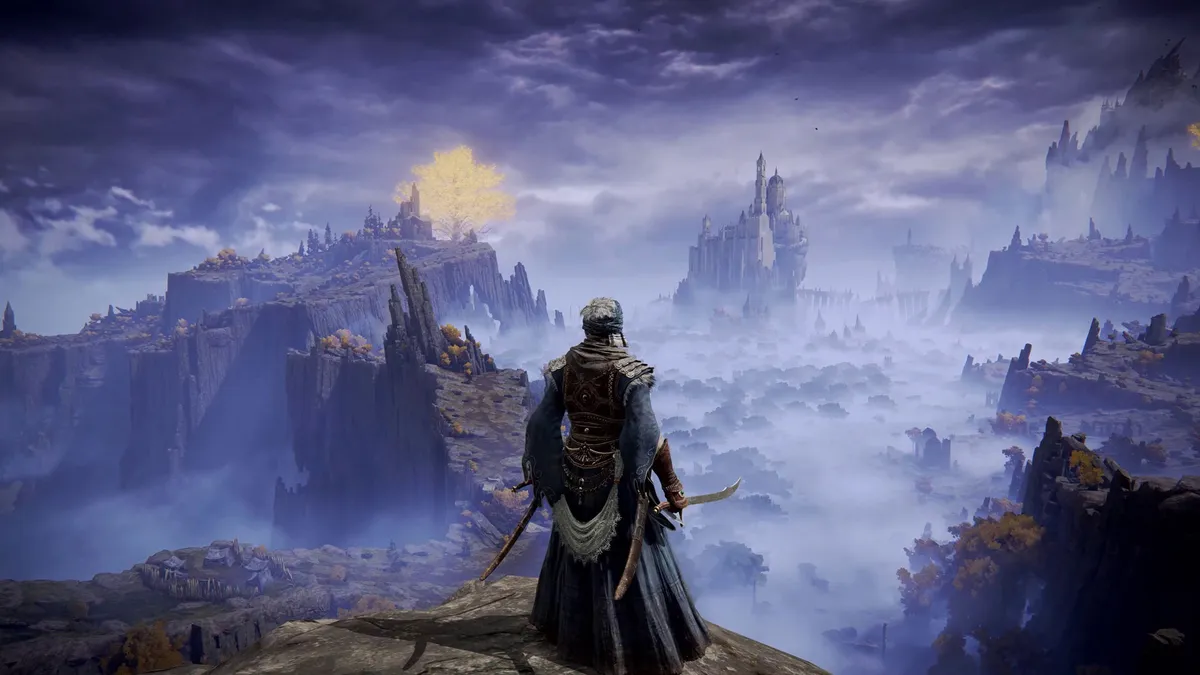The first region players discover when they ask, where does Elden Ring take place, is Limgrave. It’s a land of gentle hills, open fields, and ancient ruins scattered across its plains. The golden light of the Erdtree shines bright here, creating a feeling of hope and discovery. However, peace is an illusion. Limgrave hides dangerous caves, crumbling fortresses, and corrupted knights who still cling to power after the fall of their ruler, Godrick the Grafted.
Limgrave is designed as a perfect starting point—it teaches players how the world of the Lands Between breathes and moves. You’ll find wildlife roaming freely, ruins to explore, and a castle that watches over the land from afar. It represents both freedom and challenge, setting the tone for what’s to come.
Liurnia of the Lakes and the Altus Plateau
Beyond Limgrave lies Liurnia of the Lakes, a mist-covered land surrounded by deep waters and magic. It’s home to the Raya Lucaria Academy, where sorcerers study the stars and ancient magic. The region feels calm yet lonely, filled with the echoes of wisdom and war. You’ll meet scholars, ghosts, and guardians who protect secrets left behind.
Moving higher, the Altus Plateau takes players closer to the Erdtree itself. Bathed in golden light, this area holds the grand capital, Leyndell, once the beating heart of the Lands Between. Walking through its ruined streets, you see statues of gods and kings now reduced to dust. This golden region reminds you that even divine kingdoms fall
Caelid, Mountaintops, and the Hidden Realms
If Limgrave is beauty, Caelid is horror. Covered in crimson rot and black skies, Caelid is one of the most haunting areas where Elden Ring takes place. Once a thriving land, it was destroyed by the spread of a deadly disease known as the Scarlet Rot. Here, monsters roam freely, and the ground burns with corruption. It’s ruled by General Radahn, a demigod warrior who has lost his sanity.
Further north, the Mountaintops of the Giants offer freezing winds, endless snow, and forgotten temples. These peaks were once the home of giants who fought against the gods. Now, only ruins remain, and fire spirits wander the ice fields. Beneath the surface, there are hidden lands like the Ainsel River and Deeproot Depths, proving that the Lands Between has layers—both above and below the earth
Quick Region Overview
| Region | Key Feature | Notable Ruler/Entity |
|---|---|---|
| Limgrave | Open plains, ruins, and castles | Godrick the Grafted |
| Liurnia of the Lakes | Water-filled terrain, magic academy | Rennala, Queen of the Full Moon |
| Caelid | Scarlet rot wasteland | General Radahn |
| Altus Plateau | Golden highlands, capital city | Queen Marika’s legacy |
| Mountaintops of the Giants | Snowy peaks, fire temples | Fire Giants |
| Haligtree | Hidden divine realm | Malenia, Blade of Miquella |
Who Rules the Lands Between?
Queen Marika and the Golden Order
At the center of where Elden Ring takes place stands Queen Marika the Eternal. She was the divine ruler who shaped the world using the power of the Elden Ring, an artifact that governed life, death, and order. Marika’s vision created the Golden Order, a system that kept balance in the Lands Between for centuries. But her rule wasn’t perfect—it demanded obedience, and when the ring shattered, her order collapsed with it.
Marika’s story is one of sorrow and control. She desired to make her world eternal, yet her children—each a demigod—fought to replace her. The moment she vanished, her realm began to fall apart.
The Demigods and the Tarnished
After the Shattering of the Elden Ring, the demigods began warring for the broken pieces called Great Runes. Each demigod controls a region, reshaping it to their image. For example, Radahn turned Caelid into a cursed wasteland, while Malenia’s influence spread the Scarlet Rot.
You, the Tarnished, are summoned back to this broken world. You are a fallen warrior blessed by grace, meant to either restore the old order or create a new one. This balance between gods, demigods, and mortals is what makes where Elden Ring takes place so unique—a world where divine power has collapsed, leaving room for new legends.
How the World’s History Shapes the Place
The Creation of the Lands Between
Before chaos, the Lands Between was a paradise. The Greater Will, a mysterious cosmic force, sent the Elden Ring to guide life. From this power grew the Erdtree, the glowing symbol that blesses and watches over everything. Under Queen Marika’s rule, immortality flourished—souls did not die but returned to the tree.
This world was built on divine magic and faith, but as time passed, corruption crept in. Some began to question the gods, and others sought their own power. The result was inevitable: the Shattering.
The Shattering and the Fall of Grace
When the Elden Ring broke, everything changed. Lands that once shined gold became covered in rot and ash. The divine energy faded, and the people lost their grace. Without the ring’s power, even the Erdtree began rejecting souls, leaving the Lands Between trapped between life and death.
The world you explore in Elden Ring is a result of this downfall. Every ruin, every broken statue, and every scar in the landscape tells the story of that loss. This makes the setting feel alive—because it is built on the remains of something once divine.
Why Knowing “Where Elden Ring Takes Place” Matters
For Story and Immersion
Understanding where Elden Ring takes place helps you connect with the story on a deeper level. Knowing that the Erdtree once gave life meaning or that Caelid’s red skies are the result of a war gone wrong turns exploration into discovery. The setting isn’t random—it’s a reflection of history, religion, and ambition.
When you explore ruins or fight a boss, you’re not just playing—you’re uncovering fragments of the world’s soul. This connection makes every victory feel personal, as if you’re helping rebuild what was lost.
For Gameplay and Exploration
Knowing the regions helps players plan and survive. Each area has its own dangers and treasures—snowy paths demand fire resistance, while Caelid’s rot requires strong healing. By understanding the world design, you gain both strategy and appreciation for how carefully the Lands Between is built.
Elden Ring rewards those who explore with curiosity. And the more you know about the world, the more meaningful your journey becomes.
FAQs About Where Elden Ring Takes Place
1. Is Elden Ring set in the same world as Dark Souls?
No. While it feels similar, Elden Ring takes place in a separate universe called the Lands Between. It shares spiritual themes, but it’s a completely new world.
2. What is the meaning of “The Lands Between”?
It means a realm between life and death, heaven and earth—a middle ground for gods and mortals.
3. Who created the world of Elden Ring?
The world was co-created by Hidetaka Miyazaki and George R. R. Martin, blending game design with mythological storytelling.
4. Is the Erdtree alive?
Yes. It represents the power of the Elden Ring itself—a living symbol of divine grace that watches over the land.
5. Will the DLCs expand the Lands Between?
Yes, expansions like Shadow of the Erdtree reveal new regions and deepen the lore of where Elden Ring takes place.
Conclusion
So, where does Elden Ring take place?
It takes place in the Lands Between—a world of gods, decay, and endless mystery. This realm, shaped by light and shadow, invites you to explore, fight, and uncover the truth behind the golden glow of the Erdtree.
Whether you walk through Limgrave’s grasslands or Caelid’s rot-infested swamps, every step reveals a story. The Lands Between is more than a setting—it’s a reflection of human ambition, loss, and rebirth.
As the Tarnished, you’re not just a traveler—you’re part of the legend that decides the future of this dying yet beautiful world.
Read more: Where We Stand: Is Solo Leveling Season 3 Officially Confirmed?














